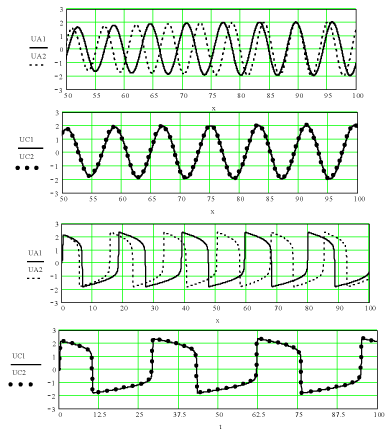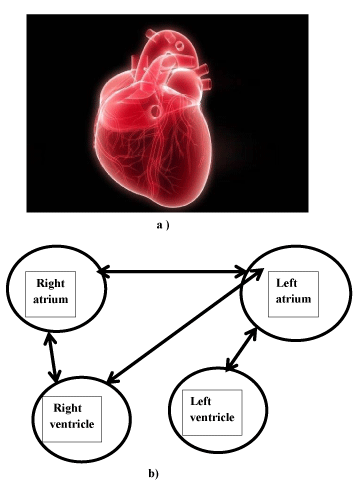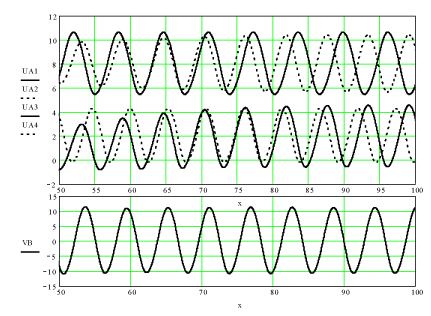Journal of Cardiovascular Medicine and Cardiology
A mathematical description of the arrhythmia of the heart
VI Kaganov*
Cite this as
VI Kaganov (2019) A mathematical description of the arrhythmia of the heart. J Cardiovasc Med Cardiol 6(3): 042-044. DOI: 10.17352/2455-2976.000090The problem of synchronization of oscillations of various physical nature is discussed. From the standpoint of the theory of synchronism, the model of the heart is considered as a system of four interconnected between self-oscillatory objects: two atria and two ventricles. The synchronous and asynchronous modes of operation with sinusoidal and relaxation oscillations are considered. A computer program simulating the electrical oscillations occurring in the heart has been compiled using four differential equations. Examples of calculation by the program are given for asynchronous and synchronous modes of operation. The possibility of evaluating the ablation procedure from the standpoint of a computer model mate is discussed.
Synchronization Overview
In various structures of physical nature (mechanical electronic, biological and other types), the existence of a synchronism regime is possible, i.e. exact coincidence of oscillations up the shape and frequency of a set of objects that are weakly interconnected.
So, for example, the pendulums of a group of clocks placed on a common wall of a material transmitting vibrations begin to oscillate absolutely exactly. However, in such a clock, taken from the wall, the oscillation frequency of the pendulums is different. This phenomenon, called the synchronization of oscillations, was first discovered by the Dutch physicist Christian Huygens in the middle of the seventeenth century.
So, synchronization is a physical phenomenon consisting in the exact coincidence of oscillations of a group of interconnected objects. The synchronization law also obeys the human heart, in which the two atria (right and left) and the two ventricles constantly contract together in a single rhythm [1,2]. Violation of synchronous oscillations of these links leads to many serious internal human diseases, united by the common name cardiac arrhythmia [3,4].
Without pretending to any recommendations to combat cardiac arrhythmia, we consider this phenomenon from the standpoint of mathematics, which may allow for a deeper understanding of the existing methods of treatment with this human disease.
The basis of the mathematical analysis put the following provisions:
- four parts of the heart, making rhythmic vibrations, are presented in the form of four self-oscillating links,
- connected between these links, carried out by the conducting layer of the myocardium and the vessels, is estimated using some coefficients,
- The basis of the model is based on four differential equations.
Synchronous and asynchronous operation of two oscillatory links.
The processes occurring in a single self-oscillatory link will be described using the non-linear van der Pol differential equation [5], which is the basis of the analysis of an electronic self-oscillator [6].
In the case of two interconnected auto-oscillatory objects, their joint work is described using two such equations:
where k1 and k2 are the coupling coefficients between the links, τ= ωt is the oscillation phase, ω = 2π /T is the circular frequency of the self-oscillations of the link, T is the period of these oscillations; q1, q2 are the coefficients that determine the ratio of the natural frequency of each of self-oscillating link to the frequency of synchronous oscillations, µ1, µ2 are the parameters that determine the shape of the oscillations (for µ <1, the oscillations are close to sinusoidal, for µ> 3 - to relaxation oscillations).
The solution of equations (1) will be found numerically using a computer program (Appendix 1). Figure 1 shows the four results of such a decision. We explain them.
The functions UA1 (x), UA2 (x) c correspond to the asynchronous mode of operation (coefficients; k1 = k2 = 0), at which the oscillations are different in frequency. The functions UC1 (x), UC2 (x) correspond to the synchronous mode of operation (coupling coefficients k1 = 0.4; k2 = 0.6), in which both oscillations are identical. The parameters sine waves correspond to µ1 = µ2 = 0.1; relaxation µ1 = µ2 = 10.
Based on these four examples, the following conclusions can be drawn. At µ = 0.1, the oscillations are sinusoidal, and at µ = 10, the oscillations are reborn into relaxation ones. In the absence of a link between the self-oscillating links (coupling coefficients k1 = 0 and k2 = 0), the process in each of them proceeds independently and therefore the oscillations in frequency differ from each other.
In the presence of a connection between self-oscillating links (coupling coefficients k1 = 0.4 and k2 = 0.6), interaction occurs between them and the system as a whole goes into synchronism mode, i.e. in exact match of two vibrations. Similar phenomena occur in the system with both sinusoidal and relaxation oscillations.
Synchronous and asynchronous modes of the heart model
The model of the heart (Figure 2a), treated as a system consisting of four oscillatory units (two atria and two ventricles) with connections between them, assessed using the coefficients k1 - k6, is shown in figure 2b.
where the same notation is used as in equations (1).c
The solution of equations (1) will be found numerically using a computer program (Appendix 2). Figure 3 shows the four results of such a decision. We explain them.
Functions UA1 (x), UA2 (x), UA3 (x), UA4 (x), c correspond to the asynchronous mode of operation (coupling coefficients k1 ... k6 = 0), at which the oscillations are different in frequency.
The functions UВ (x) is the sum of four oscillations that are identical in frequency during synchronous operation, at which all the coupling coefficients between self-oscillating links k1 .. k6> 0 (Appendix 2).
Note that on all the graphs on the abscissa axis, the oscillation phase is x = ωt, where the circular frequency is ω = 2π / T, T is the period of these oscillations. In a healthy heart T = 0.7 -1 s, which corresponds to 60 -90 beats per minute. According to the above ratio in the constructed graphs, knowing the oscillation period T, it is easy to move from phase to time.
We present one of the possible interpretations of the considered examples of computer analysis. by referring to the ablation procedure [7]. As is well known, ablation consists of exposing proteins to tissues and rejecting a part of the cells in the heart structure by radio frequency or laser radiation. From the standpoint of the model under consideration, this procedure can be interpreted as establishing the required coupling coefficients kn between the four vibrating parts of the heart to ensure a stable mode of synchronism in its work.
Conclusion
Compiled computer model of the heart in the form of a system of four differential equations helps from the standpoint of mathematics to more deeply comprehend violations in the rhythmic, synchronous work of the heart.Such a mathematical understanding of the physical processes that take place in the heart may help to develop new ways of overcoming the ailment called “cardiac arrhythmia.”.
- AV Ardashev, M Medpraktika (2009) Anatomy and physiology of the cardiac conduction system. Clinical arrhythmology
- (1985) ↑ Go to: 1 2 Kositsky GI Human Physiology. - 3rd ed. - M: Medicine.
- Zudbinov Yu I (2013) Alphabet ECG. Rostov.
- Ebert G (2010) Simple ECG analysis. Logosphere.
- (1977) Mathematical encyclopedia. Soviet Encyclopedia 1.
- Kaganov VI (2018) Radio circuits and signals. Computerized course. 4th edition. - M.: Forum - Infra-M.
- Ablation of the heart is one of the methods of treatment of arrhythmia. The Internet. Link: http://bit.ly/2MgCyhJ






